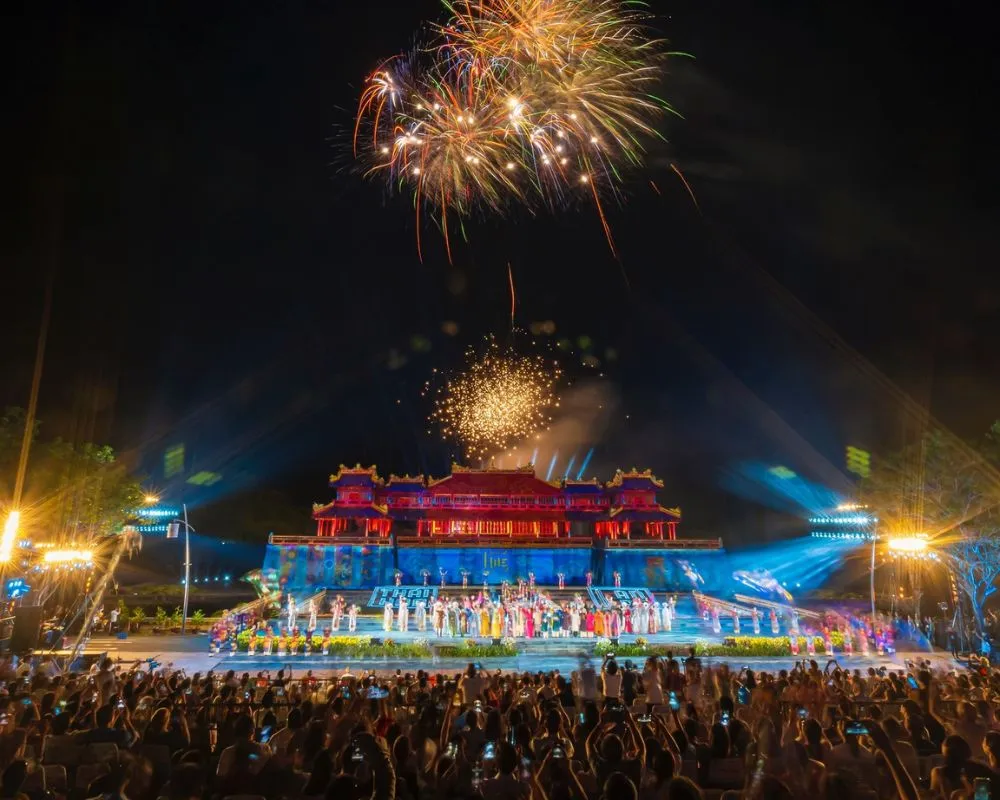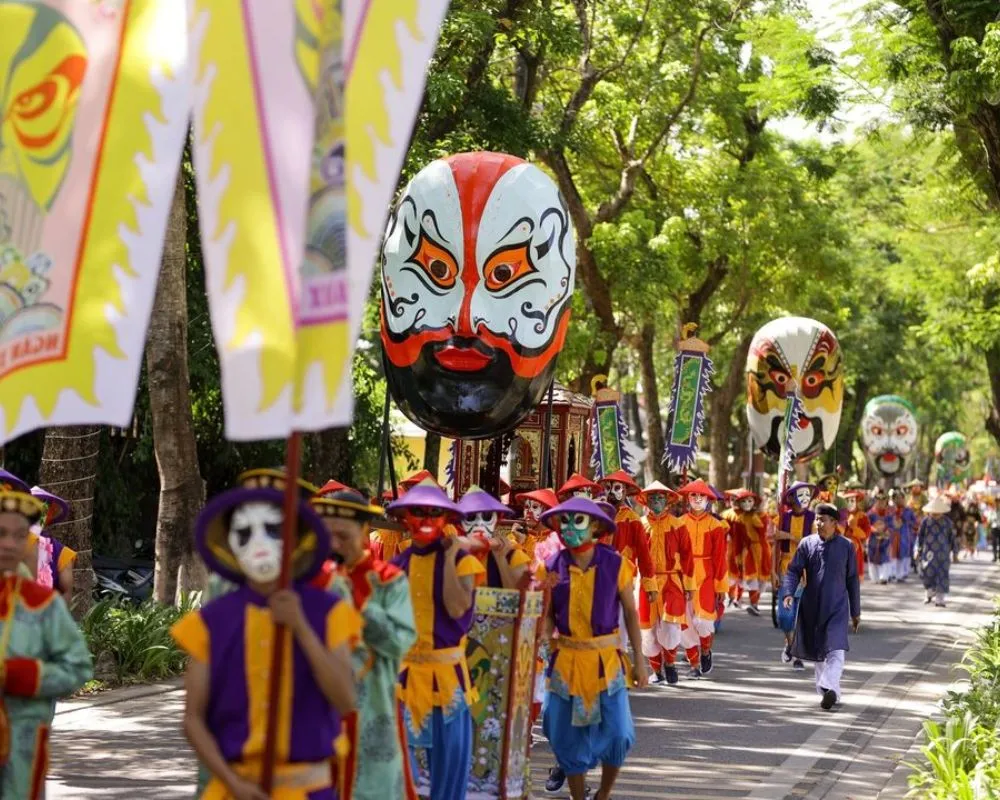Hue, the ancient capital steeped in history and poetic beauty along the Perfume River, truly comes alive during the spectacular Hue Festival. More than just a series of events, it’s a grand celebration of Vietnam’s rich cultural heritage, especially that of the former imperial city. As a traveler deeply passionate about connecting with destinations through their stories, traditions, and flavors, I find the festival a powerful portal to understanding the soul of Hue. Get ready to immerse yourself in a world of art, history, and unforgettable experiences that showcase the unique blend of royal grandeur and folk charm.
The roots of the Hue Festival trace back to 1992 with a Franco-Vietnamese event, evolving into the grand biennial celebration officially recognized in 1998 and first held in 2000. Its core mission is profound: to safeguard and promote the unique cultural tapestry of Hue and Vietnam. This isn’t just about putting on a show; it’s a vital act of cultural preservation, bringing the ancient traditions of the Nguyen Dynasty era into the modern light. It serves as a crucial platform to showcase Hue’s status as a UNESCO World Heritage site and a beacon of Vietnamese culture to the world.
Visiting Hue during the Hue Festival is an experience unlike any other time of the year. The normally serene city transforms into a dynamic stage where history leaps from the pages and art spills onto the streets. The atmosphere is electric, a palpable buzz of anticipation and joy. You feel the weight of centuries of history mingling with the vibrant energy of contemporary artistic expression, creating a truly unique sensory journey. It’s a feast for the eyes, ears, and soul.
Why Hue Festival 2025 is Special
The upcoming Hue Festival in 2025 holds particular significance. Commemorating the 50th anniversary of the liberation of Thua Thien Hue province, this edition is poised to be one of the most memorable yet. It also aligns with the National Tourism Year 2025, placing Hue firmly in the spotlight as a premier cultural destination. This confluence of events guarantees an expanded program filled with diverse performances, exhibitions, and community activities designed to engage and inspire.
The festival is a vibrant tapestry woven from threads of past and present. It honors the imperial legacy while embracing modern artistic innovation. International troupes often join local artists, creating a fascinating dialogue between global cultures and Vietnamese heritage. This blend ensures there’s something captivating for every visitor, from the history buff and the art connoisseur to the curious first-time traveler.
Experiencing the Highlights of Hue Festival
Stepping into the Hue Festival means stepping into a whirlwind of cultural activity. The official opening ceremony is a spectacle not to be missed. Held with great pomp and circumstance, it often features elaborate performances, historical reenactments, and culminates in a stunning fireworks display that lights up the night sky over the Perfume River, setting a majestic tone for the days to follow.
 A traditional performance on the Perfume River during the Hue Festival
A traditional performance on the Perfume River during the Hue Festival
What to Eat in Fort Worth – A Culinary Deep Dive
Discover the Top Restaurants in Denver – A Culinary Journey
Discover Where to Visit in Las Vegas
Royal arts take center stage, offering a rare glimpse into the refined culture of the imperial court. Vietnamese court music (Nhã Nhạc), recognized by UNESCO as an Intangible Cultural Heritage of Humanity, is performed with exquisite grace and precision. Witnessing these ancient melodies and dances within the grounds of the Imperial Citadel evokes a powerful sense of connection to Vietnam’s dynastic past.
Beyond the courtly elegance, the festival celebrates the rich diversity of Vietnamese folk traditions. Stages across the city host performances of traditional theater (Tuồng), folk singing (Ca Huế), puppetry, and various regional dances. These vibrant and often interactive shows provide insight into the everyday lives, beliefs, and artistic expressions of the Vietnamese people throughout history.
Art enthusiasts will find plenty to explore in the numerous exhibitions scattered across Hue. These displays showcase a range of artistic mediums, from traditional painting and sculpture to contemporary installations. Many exhibitions focus on the intricate traditional crafts of Hue, such as conical hat making, incense production, and bronze casting, offering a deeper appreciation for the skills passed down through generations.
 Spectacular fireworks illuminate the night sky over Hue during the opening ceremony of the Hue Festival
Spectacular fireworks illuminate the night sky over Hue during the opening ceremony of the Hue Festival
No exploration of the Hue Festival would be complete without indulging in the city’s legendary cuisine. Hue is renowned throughout Vietnam for its distinct culinary heritage, a delicious fusion of royal gastronomy and flavorful street food. The festival features dedicated culinary events where you can sample a vast array of local specialties.
Hue’s food tells a story – reflecting both the elaborate multi-course meals of the emperors and the simple, vibrant dishes of the common people. Look for iconic dishes like Bún bò Huế (spicy beef noodle soup), Bánh lọc (clear shrimp dumplings), Nem lụi (lemongrass pork skewers), and the colorful array of Chè (sweet soups). Culinary demonstrations offer insights into the preparation techniques and the cultural significance behind each bite.
The streets of Hue become lively stages during the festival. Street parades are a major highlight, featuring elaborate floats, traditional costumes, marching bands, and performances that weave their way through the city’s historic thoroughfares. The energy is infectious, drawing crowds of locals and tourists alike to watch and participate in the celebration.
 The procession with traditional Hue’s Tuong masks
The procession with traditional Hue’s Tuong masks
A particularly beautiful and culturally significant event is the Ao Dai show. The Ao Dai, Vietnam’s elegant traditional dress, is celebrated through fashion shows and exhibitions showcasing its evolution from historical designs to contemporary interpretations. Witnessing the grace and beauty of the Ao Dai against the backdrop of Hue’s imperial architecture is a truly memorable experience.
Beyond the main performances, the Hue Festival often includes workshops where you can try your hand at traditional crafts or arts, cultural exchange programs, and tourism fairs. Community-based events, including environmental initiatives and public art projects, highlight Hue’s commitment to sustainable development and local engagement, adding another layer to the festival’s purpose.
 Traditional music and dance performance near Thanh Toan Tile-roofed Bridge, highlighting folk culture at the Hue Festival
Traditional music and dance performance near Thanh Toan Tile-roofed Bridge, highlighting folk culture at the Hue Festival
Planning Your Trip to Hue for the Festival
Visiting Hue during the Hue Festival requires a little planning, but the rewards are immense. The festival attracts a significant number of visitors, especially for major editions like 2025. This means accommodation and transportation book up quickly, so securing your bookings well in advance is highly recommended.
The weather in Hue during the festival period (usually late spring/early summer) can be warm and humid, possibly with occasional rain showers. Pack light, breathable clothing. Comfortable walking shoes are essential as you’ll be doing a lot of exploring. Remember to pack more modest attire if you plan to visit religious sites like pagodas or temples out of respect for local customs.
While credit cards are accepted at larger hotels and restaurants, many smaller vendors, local shops, and street food stalls operate on a cash-only basis. Having Vietnamese Dong readily available will make transactions smoother, especially when exploring the vibrant local markets or grabbing a quick bite during the festival buzz.
Stay hydrated, especially during the warmer parts of the day. Carry bottled water, use sunscreen, and wear a hat. Depending on the season and location (e.g., near the river or gardens), insect repellent might also be useful. Be prepared for crowds, particularly around the main event venues and during popular parades. Patience and flexibility are key to navigating the festival atmosphere.
Getting around Hue during the festival can be challenging due to increased traffic and road closures for events. Walking is a great way to soak in the atmosphere, especially around the Imperial City and along the riverbanks. Cyclos and taxis are available, though fares might surge. For exploring multiple sites or traveling between venues comfortably, especially during peak times, considering hiring a car with a driver can offer a convenient and efficient option. They can navigate the busy streets and provide local insights.
Beyond the Festival Fun
While the festival is the main draw, take time to explore Hue’s permanent treasures. Wander through the majestic Imperial Citadel and the Forbidden Purple City, feeling the echoes of imperial life. Visit the serene Thien Mu Pagoda overlooking the Perfume River, or take a relaxing boat trip to appreciate the city’s scenic beauty. Exploring the elaborate royal tombs scattered outside the city offers a fascinating glimpse into the philosophies and artistic styles of different emperors. Combining these timeless sights with the vibrant festival events creates a comprehensive and unforgettable Hue experience.
Conclusion
The Hue Festival is a magnificent testament to Vietnam’s enduring cultural spirit and Hue’s unique position as the heart of its imperial past. It’s an opportunity to witness history brought to life, to be moved by traditional performances, to savor incredible flavors, and to connect with the warmth of the Vietnamese people. For any traveler seeking a deep dive into culture, history, and vibrant local life, making the journey to Hue during the festival is an absolute must. It’s more than just attending an event; it’s immersing yourself in a living, breathing piece of Vietnamese heritage.
FAQ about Hue Festival
When does the Hue Festival usually take place?
The Hue Festival is a biennial event, meaning it is held every two years. The exact dates vary but typically fall around late spring or early summer (April-June). For example, the 2025 festival is scheduled to begin in late March.
How long does the Hue Festival last?
The Hue Festival usually runs for about a week to ten days, packed with events and activities from morning until late evening.
What are the best events to see at the Hue Festival?
Must-see events often include the grand opening ceremony and fireworks display, performances of Vietnamese court music (Nhã Nhạc) within the Citadel, the street parades featuring traditional costumes and art, the Ao Dai fashion show, and the culinary exhibitions and tastings.
Is it crowded during the Hue Festival?
Yes, the Hue Festival, especially significant editions like 2025, attracts large crowds of both domestic and international tourists. Expect busy streets, crowded venues, and high demand for accommodation and services.
What’s the best way to get around Hue during the festival?
Getting around can be challenging due to crowds and potential road closures. Walking is ideal for nearby areas. Taxis and cyclos are available, but booking transport in advance or considering hiring a car with a driver can be helpful for longer distances or navigating peak times.
